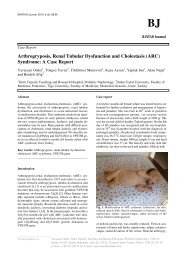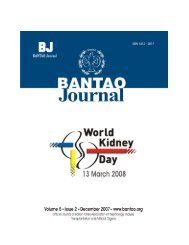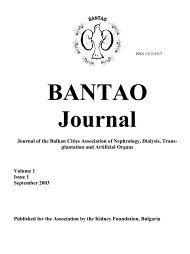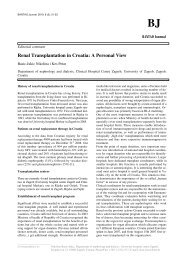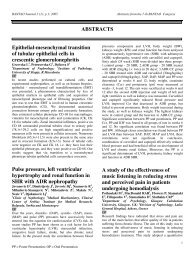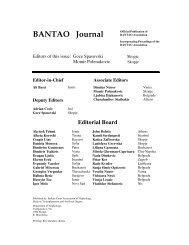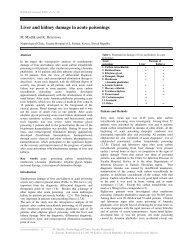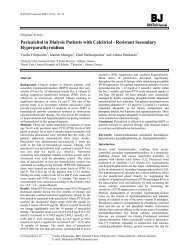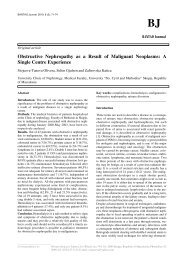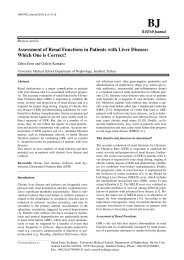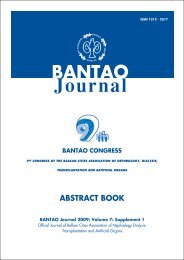Adynamic Bone Disease - Clinical Outcome of ... - BANTAO Journal
Adynamic Bone Disease - Clinical Outcome of ... - BANTAO Journal
Adynamic Bone Disease - Clinical Outcome of ... - BANTAO Journal
You also want an ePaper? Increase the reach of your titles
YUMPU automatically turns print PDFs into web optimized ePapers that Google loves.
<strong>BANTAO</strong> <strong>Journal</strong> 3 (2): p 153; 2005<br />
<strong>Adynamic</strong> <strong>Bone</strong> <strong>Disease</strong> - <strong>Clinical</strong> <strong>Outcome</strong> <strong>of</strong> the Treatment with Different<br />
Dialysate Calcium Concentration<br />
G. Spasovski 1 , S. Gelev 1 , A. Sikole 1 , J.Masin-Spasovska 1 ; M. Bogdanova 2 , S. Subeska Stratrova 3 , V. Amitov 1 , N. Stojcev 1 , R.<br />
Grozdanovski 1 , K Zafirovska 1<br />
1 Dept. <strong>of</strong> Nephrology, 2 Institute <strong>of</strong> Biochemistry, 3 Dept. <strong>of</strong> Endocrinology, <strong>Clinical</strong> Center, Skopje, R. Macedonia<br />
Introduction<br />
The abnormalities in bone histology in patients with<br />
chronic renal failure (CRF), known as renal osteodystrophy<br />
(ROD), can be observed early in the course <strong>of</strong> the disease.<br />
Over the last decades the spectrum <strong>of</strong> ROD in dialysis<br />
patients has been studied thoroughly and the prevalence <strong>of</strong><br />
the various types <strong>of</strong> renal bone disease changed over the<br />
years (1). In recent years, adynamic bone disease (ABD)<br />
has become the most prevalent bone lesion within the<br />
dialysis population. This type <strong>of</strong> ROD was first found in<br />
association with high bone aluminum accumulation (2).<br />
Other factors that might have played an important role in<br />
development <strong>of</strong> ABD consist <strong>of</strong> malnutrition, male<br />
predominance, diabetes mellitus and advanced age (3-5).<br />
Calcium-based binders, particularly when used in<br />
combination with vitamin D analogues, may result in oversuppression<br />
<strong>of</strong> PTH (6). However, it was observed that<br />
most <strong>of</strong> the cases with ABD were found in patients with<br />
"relative" hypoparathyroidism, i.e parathyroid hormone<br />
(PTH) levels that are significantly lower than those noted in<br />
renal failure patients with other types <strong>of</strong> ROD, but still<br />
higher than in subjects with normal renal function (7).<br />
<strong>Bone</strong> biopsy is considered as the gold standard for ROD<br />
diagnosis (8), but various biochemical markers have been<br />
most frequently evaluated over the last decades.<br />
Predominantly, the investigators measure intact parathyroid<br />
hormone (iPTH), total or ionized serum calcium (Ca),<br />
phosphate (P), alkaline phosphatase (AP), vitamin D status<br />
and some markers <strong>of</strong> either bone formation [bone alkaline<br />
phosphatase (BAP), osteocalcin (OC)] or bone resorption<br />
[(deoxy-) pyridinolines (DPYD, PYD)]. Most <strong>of</strong> these<br />
markers reach a high enough diagnostic performance to<br />
substitute bone histomorphometry.<br />
Disturbances <strong>of</strong> calcium-phosphate (Ca-P) metabolism in<br />
CRF play an important role not only in bone disease but<br />
also in s<strong>of</strong>t tissue calcification, with an increased risk <strong>of</strong><br />
vascular calcification, arterial stiffness, and worsening <strong>of</strong><br />
atherosclerosis, linked to an increased mortality in a large<br />
number <strong>of</strong> dialysis patients. On the other side, the use <strong>of</strong><br />
calcium salts for phosphate binding is complicated by the<br />
development <strong>of</strong> hypercalcemia and an increased risk <strong>of</strong><br />
metastatic calcifications in a substantial fraction <strong>of</strong> patients<br />
particularly those taking vitamin D analogues and those<br />
with adynamic bone disease (6). Moreover, ABD patients<br />
show a reduced ability to handle an exogenous calcium<br />
load, and have a more sustained hypercalcaemia, implying<br />
a higher risk <strong>of</strong> extra-osseous calcifications. Hence, a<br />
suitable dialysate calcium concentration is important and<br />
must take into consideration the medical therapy and the<br />
calcium balance on an individual patient basis.<br />
Despite all the controversy, numerous investigators have<br />
suggested that using low-calcium dialysate (LCD) might<br />
benefit HD patients, allowing a larger dose <strong>of</strong> calcium to<br />
control hyperphosphatemia and avoiding excessive PTH<br />
suppression (9,10). Nevertheless, the information about the<br />
stimulating effect <strong>of</strong> LDC on PTH secretion is not yet<br />
clarified.<br />
The aim <strong>of</strong> the study was to compare the effects <strong>of</strong> low<br />
(LDC) and high dialysate calcium (HDC) concentration on<br />
the evolution <strong>of</strong> adynamic bone disease in dialysis patients.<br />
Methods<br />
In this open-label study, 52 ABD presumed patients on<br />
maintenance bicarbonate haemodialysis (HD) for 12 hours<br />
per week, with low flux polysulphone or hemophane<br />
membrane were included. The key inclusion criteria was<br />
concentration <strong>of</strong> parathyroid hormone (PTH)
<strong>BANTAO</strong> <strong>Journal</strong> 3 (2): p 154; 2005<br />
received HD for a mean period <strong>of</strong> 67.5 ± 47.6 months<br />
(range: 15-228 months).<br />
The LCD and HCD group did not differ significantly in<br />
terms <strong>of</strong> age (LCD: 61 ± 11.8 years vs HCD 57.3 ± 9.9<br />
years), male gender (n=14 in each group) and time on HD<br />
(LCD: 74.7 ± 48.2 months vs HCD 59.3 ± 46.7 months).<br />
Fourteen patients had diabetes ((LCD: n=8, HCD: n=6).<br />
The groups didn't differ in the mean serum total calcium<br />
(tCa) before dialysis, but it was significantly increased in<br />
HDC group after dialysis (2.59 ± 0.18 vs 2.44 ± 0.19;<br />
p
<strong>BANTAO</strong> <strong>Journal</strong> 3 (2): p 155; 2005<br />
8. Fernandez E, Borras M, Pais B, Montoliu J. Lowcalcium<br />
dialysate stimulates parathormone secretion<br />
and its long-term use worsens secondary<br />
hyperparathyroidism. J Am Soc Nephrol 1995;6:132-<br />
135<br />
9. Argiles A, Mourad G. How do we have to use the<br />
calcium in the dialysate to optimize the management <strong>of</strong><br />
secondary hyperparathyroidism? Nephrol Dial<br />
Transplant 1998;13:( 3): 62-64<br />
10. Argiles A, Mion CM. Calcium balance and intact PTH<br />
variations during haemodiafiltration. Nephrol Dial<br />
Transplant 1995;10:2083-2089<br />
11. Fabrizi F, Bacchini G, Di Filippo S, Pontoriero G,<br />
Locatelli F. Intradialytic calcium balance with different<br />
calcium dialysate levels. Effects on cardiovascular<br />
stability and parathyroid function. Nephron 1998;72:<br />
530-535<br />
12. Yokoyama K, Kagami S, Ohkido I, Kato N, Yamamoto<br />
H, Shigematsu T, Nakayma M, Fukagawa M,<br />
Kawaguchi Y, Hosoya T. The negative Ca(2+) balance<br />
is involved in the stimulation <strong>of</strong> PTH secretion.<br />
Nephron 2002;92: 86-90<br />
_______________________________<br />
Correspondence to: Goce B Spasovski, MD, PhD, Department <strong>of</strong> Nephrology, <strong>Clinical</strong> Center Skopje, Vodnjanska 17,<br />
1000 Skopje, Macedonia, Fax: +389 2 3220 935 or +389 2 3231 501, E-mail: gspas@sonet.com.mk



